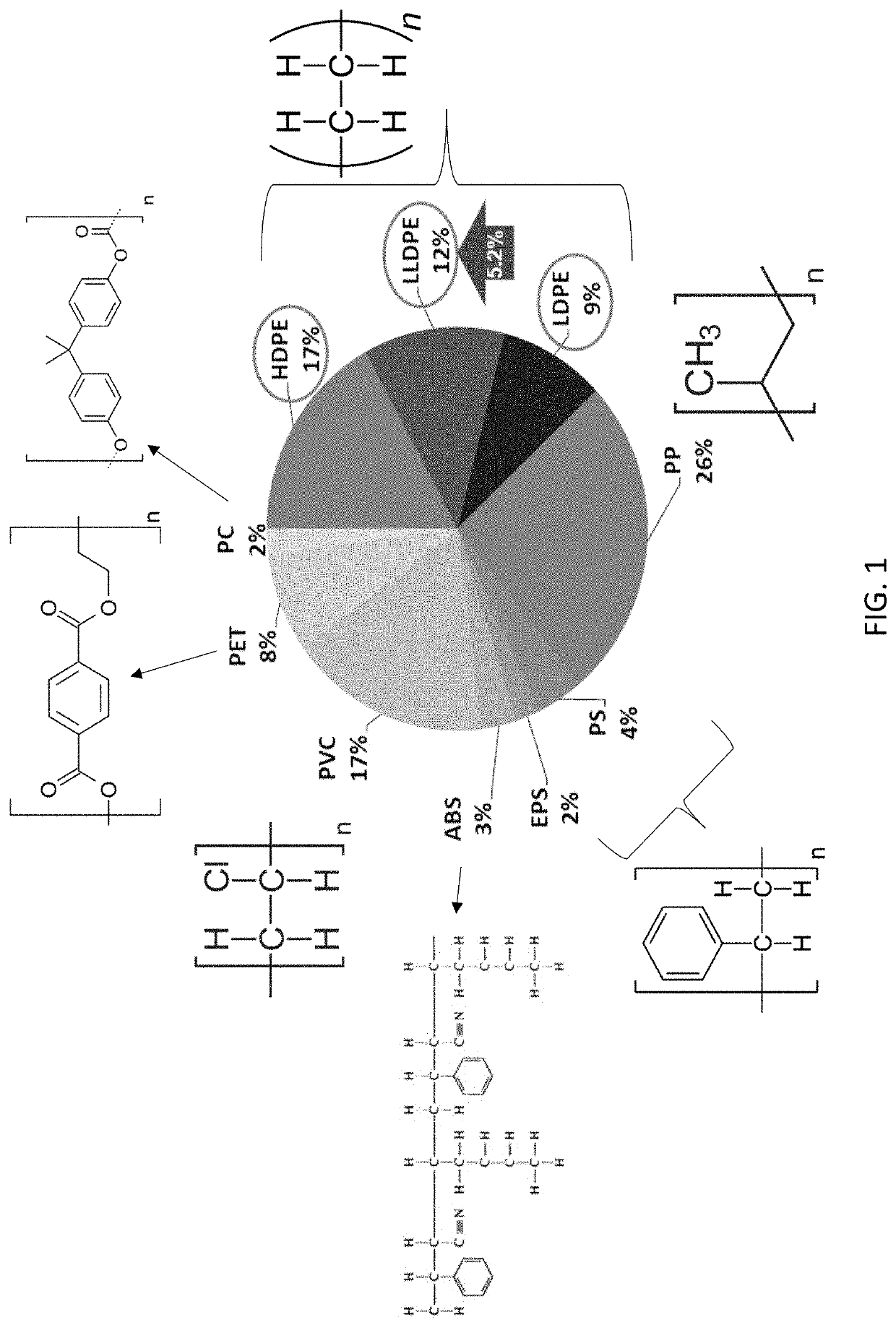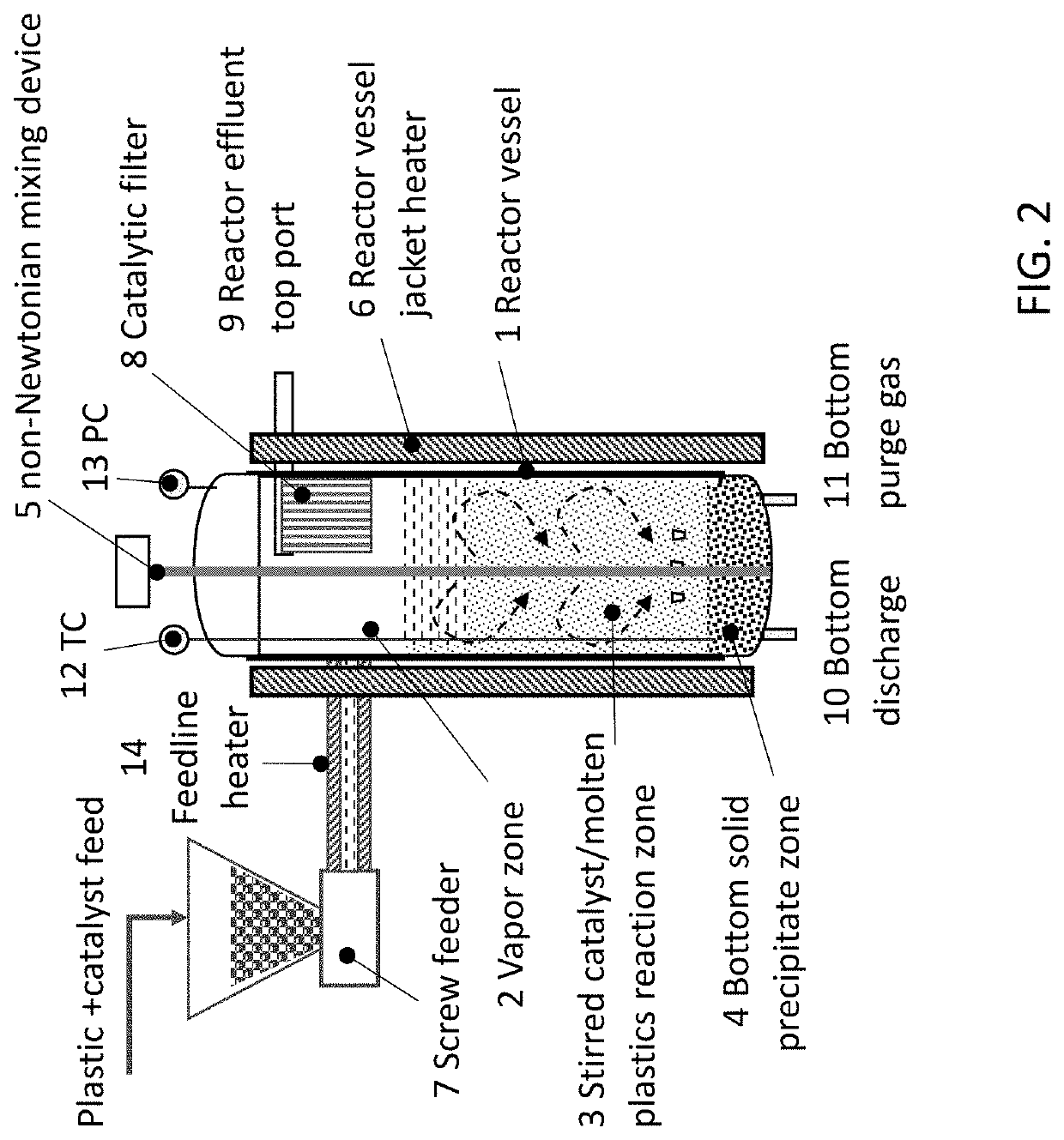Catalytic Reactor Apparatus for Conversion of Plastics
a reactor and catalytic technology, applied in the direction of chemistry apparatus and processes, physical/chemical process catalysts, metal/metal-oxide/metal-hydroxide catalysts, etc., can solve the problems of plastic waste being a huge contributor to environmental pollution, plastics are not biodegradable, and plastic waste is not biodegradabl
- Summary
- Abstract
- Description
- Claims
- Application Information
AI Technical Summary
Benefits of technology
Problems solved by technology
Method used
Image
Examples
example i
al Effects of Catalyst on Plastic Decomposition
[0077]Effects of catalyst addition on decomposition activity of the plastic were surveyed on thermogravimetric analyzer (TGA) by heating in nitrogen gas at 2° C. / min. The trash bag made of low-density-polyethylene (LDPE) was cut into fragments of a few mm sizes and blended with dry ZSM-5 zeolite powder. FIG. 11 shows weight change profiles of bare LDPE and LDPE added with two different amounts of the catalyst. There was little weight change for the bare LDPE at temperatures below 350° C. When the temperature reached about 380° C., LDPE weight rapidly decreased. Most plastics decomposed within 40 min between 380 and 470° C. Addition of 3 wt. % catalyst (Cat 1) into the LDPE fragments did not make any difference. Because the LDPE fragment was very fluffy, it was not possible to obtain uniform mixing of the LPDE and catalyst powder at this loading level in physical mixing method. The catalyst powder was segregated from the plastic fragment...
example ii
ests of PE Reactivity in Tubular Reactor
[0080]Since small amounts of the material (˜10 mg) were loaded on the sample pan in TGA tests, the material was nearly isothermal and had the temperature same or close to the sample pan temperature measured. In actual reactor operation, there could be significant temperature difference between the reactor temperature and actual material temperature. The reactivity of bare PE was tested in quartz tube reactor with the same LDPE and HDPE materials as used in Example I. The LDPE and HDPE were loaded in the respective ceramic boats, and the boats were placed inside a quartz tube reactor tube. Continuous nitrogen gas flow was used to purge inside the reactor tube while the outside of the reactor tube was heated by a furnace at 2° C. / min to 450° C. with 60 min-hold at 450° C. It was observed that complete melting of LDPE and HDPE occurred at about 370° C. and 420° C., respectively. As listed in Table 1, the theoretical melting points for LDPE and HD...
example iii
E Conversion in the Tubular Reactor
[0081]Catalytic decomposition was tested in the same tubular reactor under the same conditions as example II. The LDPE and HDPE chips were physically mixed with about 5 wt. % zeolite catalyst powder, respectively. The catalyst-added LDPE and HDPE were placed in respective ceramic boats, and the boats were loaded in the tubular reactor. Some amounts of oil vapor were observed and collected at the reactor outlet during 450° C.-hold. After the heating was done and the reactor was opened, significant amounts of wax were found deposited on the reactor tube wall in the purge gas exit region. FIG. 14a shows the wax deposit collected. All the plastic materials in the two boats were gone (FIG. 14b). There was only catalyst powder in the ceramic boat. The catalyst in the HDPE boat looked grey, while the catalyst in the LDPE boat looks black. The dark color indicates coking on the catalyst. The plastics in both boats were cracked into wax molecules that left ...
PUM
| Property | Measurement | Unit |
|---|---|---|
| channel widths | aaaaa | aaaaa |
| particle size | aaaaa | aaaaa |
| particle size | aaaaa | aaaaa |
Abstract
Description
Claims
Application Information
 Login to View More
Login to View More - R&D
- Intellectual Property
- Life Sciences
- Materials
- Tech Scout
- Unparalleled Data Quality
- Higher Quality Content
- 60% Fewer Hallucinations
Browse by: Latest US Patents, China's latest patents, Technical Efficacy Thesaurus, Application Domain, Technology Topic, Popular Technical Reports.
© 2025 PatSnap. All rights reserved.Legal|Privacy policy|Modern Slavery Act Transparency Statement|Sitemap|About US| Contact US: help@patsnap.com



